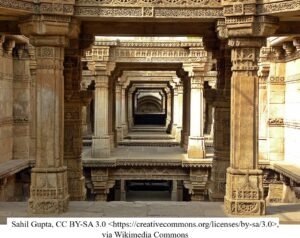भक्ति योग The Yoga of Devotion
The Bhagwad Gita
Chapter 12 (1)
Sanjya Mehta
भक्ति योग
The Yoga of Devotion
Bhakti Yog means ‘The alignment of one’s thoughts/choices/actions to Ishwar’s orders (actions rooted in Dharma) or keeping Ishwar in your thoughts and throughout daily activities.’
Bhakti comprises of various spiritual practices. It is a confluence of Karma, Upaasana and Gyan.
After listening to Bhagwan’s explanation that Bhakti (five-point program) is the straightforward way to realize and become one with Ishwar/Divinity, Arjun asked: “Which path is easier? A Sagun Bhakt (devotee who worships Brahman in manifested form ) or a Nirgun Bhakt (devotee who worships Brahman in un-manifested form
Bhagwan answered, “Though Sagun Bhakti is easier to practice, a practitioner of either form of Bhakti is considered ad true Yogi by Me. I am attainable through either path as follows:
सन्नियम्येन्द्रियग्रामं सर्वत्र समबुद्धयः,
ते प्राप्नुवन्ति मामेव सर्वभूतहितो रताः|| ४ ||
Samniyamyendriyagraamam sarvatra samabuddhayah,
Te praapnuvanti maameva sarvabhootahite rataah ||4||
Having restrained all the senses, even-minded everywhere, always engaged in the welfare of all beings – those are the devotees that can attain Me.
Although, both paths have challenges due to the bodily limitations and materialistic desires of the practitioner.
Bhagwan says that Abhyaas Yog (repeated practice is the way to overcome the challenges. Abhyaas Yog is also known as “ek roop Ishwar Dhyan” (single pointed Bhakti of a deity). If you are unable even to practice (Abhyaas Yog), perform Karma and leave the benefits of its results for my sake. You shall attain perfection.
Bhagwan further describes a path of graduation from Abhyaas (practice) to Tyaag (renunciation of the Karma phal – fruits of action)
श्रेयो हि ज्ञानमभ्यासाग्यानाध्यानं विशिष्यते,
ध्यानात्कर्मफलत्यागस्त्यागाच्छान्तिरनन्तरम् || १२ ||
Shreyo hi jnaanamabhyaasaat jnaanaaddhyaanam vishishyate,
Dhyaanaat karmaphatyaagas tyaagaacchaantir anantaram. ||12||
Knowledge (awareness) is better than practice, meditation (dhyaan/absorption of knowledge) is better than knowledge, and renunciation of fruits of action is better than meditation. Shanti (agitation-free state of mind) immediately follows renunciation.
A spiritual practice (Bhakti Yog) is not only a physical act, but it also requires knowledge and comprehension of the Shaastra for spiritual progress and self-confidence. Deeper and consistent contemplation on the messages of the Shaastra results in renunciation
Essence
“त्यागात शान्तिः अनंतरम्”
There is Shanti after renunciation of the results of actions
Image Credit
https://upload.wikimedia.org/wikipedia/commons/b/b0/Krishna_tells_Gita_to_Arjun.jpg
-
The Bhagwad Gita — Essence
Essence The Bhagwad Gita Essence Sanjay Mehta Bhagwad Gita is a well-known Hindu spiritual text. It is universally accepted, not just for its sanctity, but also as a guide in our day-to-day lives. It is essentially “a handbook of life.” Life messages from the Bhagwad Gita, such as “For the upliftment of the society (lok-sangrah)…
-
The Bhagwad Gita — Chapter 18
मोक्ष सन्यास योग Moksha Sanyaas Yoga The Bhagwad Gita Chapter 18 Sanjay Mehta मोक्ष सन्यास योग Moksha Sanyaas Yoga This chapter is a summary of Bhagwad Gita. First six chapters talk about who am I. I am the Self and not the body, the mind, or the intellect. We have wrongly identified ourselves with Body-Mind…
-
The Bhagwad Gita — Chapter 17
The Bhagwad Gita Chapter 17 Sanjay Mehta श्रद्धा त्रय विभाग योग Yog of the Divisionof the Threefold Faith Shraddha is loosely translated to faith in English. Shraddha is a firm conviction in the words of Shaastra and Guru/Aachaarya. Shraddha allows not only to know and appreciate the shaastra but also absorb ad assimilate their teachings. …


